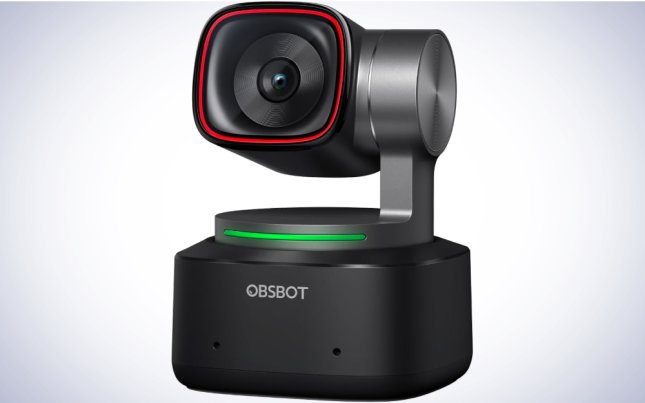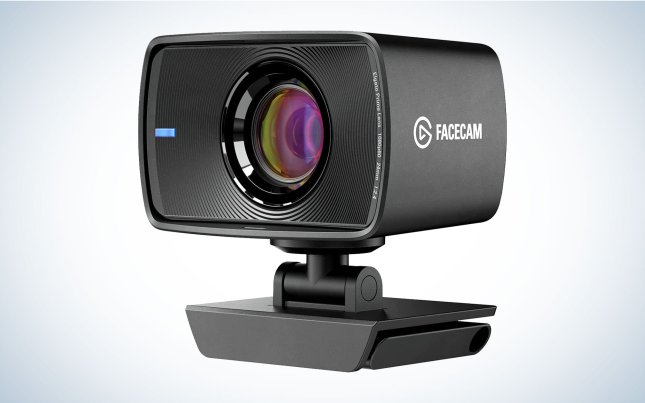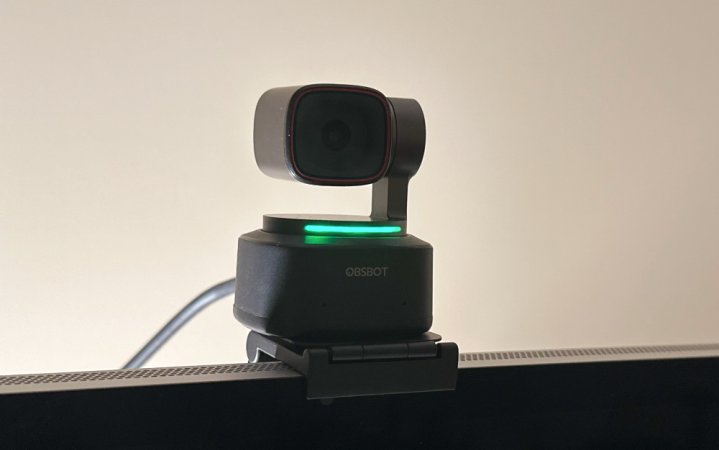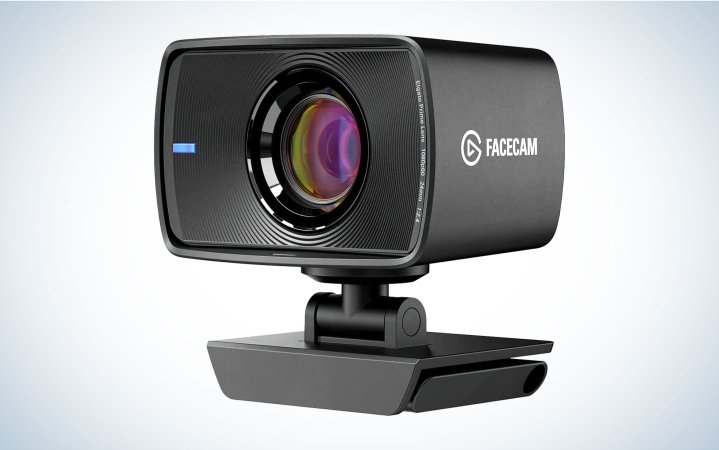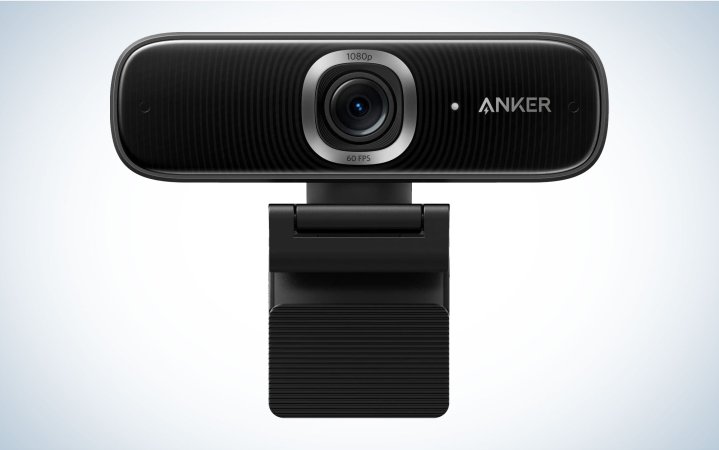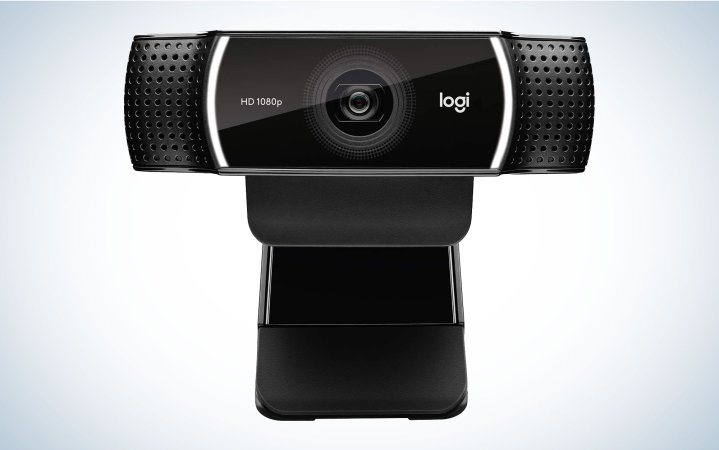We may earn revenue from the products available on this page and participate in affiliate programs. Learn more ›
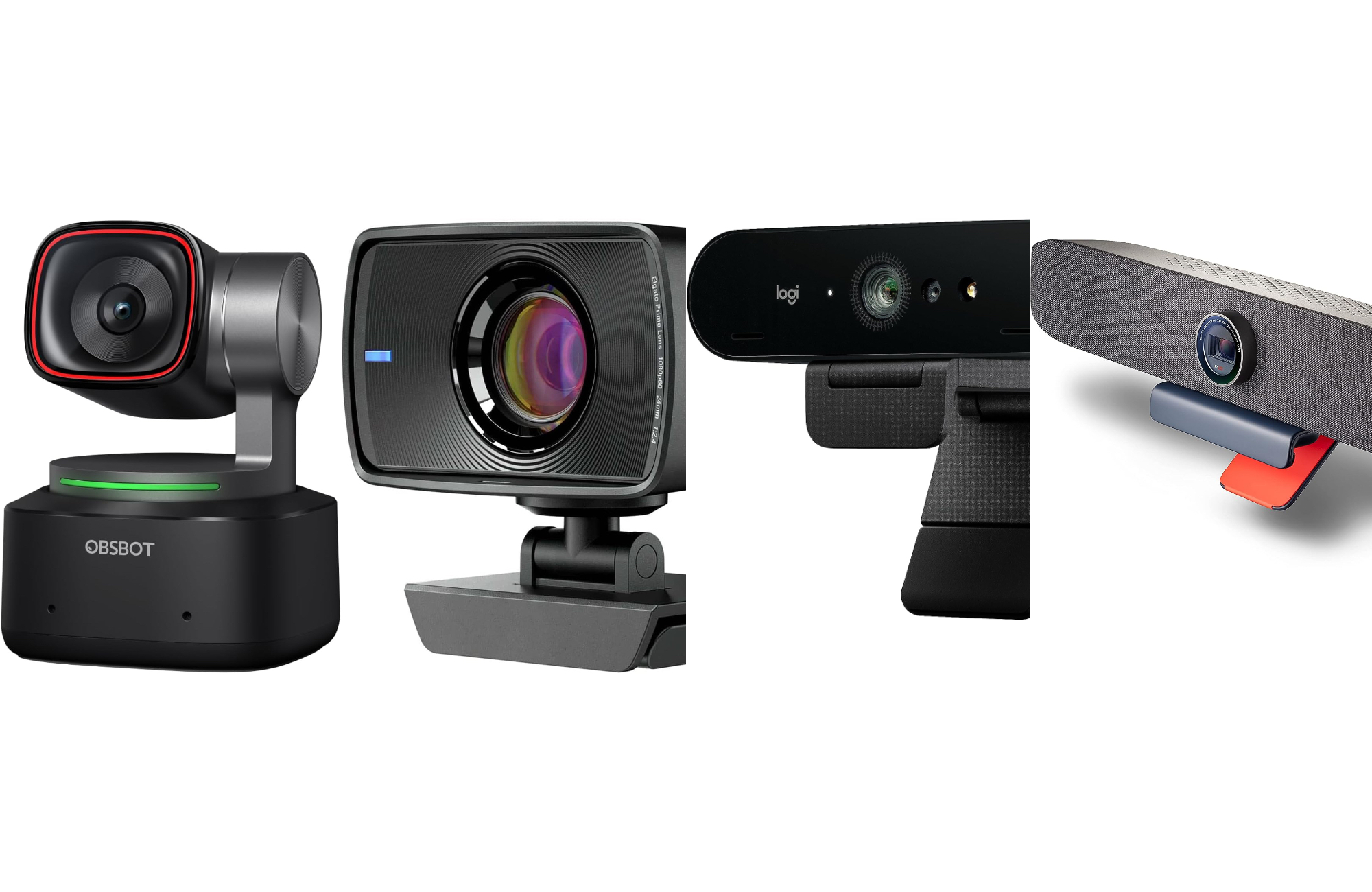
Image is everything when you’re about to start a livestream, so you’ll need a webcam for streaming. Sharp, vibrant image quality can make or break your content, whether you’re broadcasting live or recording for VOD (video-on-demand) content, and using one of the best webcams can make you look like a consummate professional or a rank amateur. For the longest time, Logitech, master manufacturer of all things office tech, had an unsurprising hold on the webcam market, including options for streaming and content creation. However, with more and more manufacturers getting into streaming gear, the landscape is changing. The best webcams for streaming will help you look—and possibly even sound—your best, whether you’re broadcasting from a naturally lit room or basking in the din of a thousand LEDs.
- Best overall: OBSBOT Tiny 2 4K
- Best for pros: Elgato Facecam
- Best webcam with microphone: Poly Studio P15 Personal Video Bar
- Best with light: AnkerWork B600
- Best adjustable field-of-view: Anker PowerConf C300
- Best 4K: Logitech Brio
- Best budget: Logitech C922x Pro Stream Webcam
How we chose the best webcams for streaming
As a freelance technology critic for over 10 years, I’ve tested work-from-home gear, including webcams, for publications including Popular Mechanics, Tom’s Guide, The Daily Beast, Architectural Digest, Apartment Therapy, and Bob Vila. All of the recommendations, except for two, are based on personal testing. The remaining webcams were selected based on the glowing recommendations from my colleagues.
The best webcams for streaming: Reviews & recommendations
The world of webcams for streaming is deeper than you might think, encompassing a wide range of feature sets and prices. We’ve monitored everything you might want to put on top of your monitor, covering all of these bases so those building their first setup and folks making a concerted effort to grow their following on Twitch will find the gear they need.
Best overall: OBSBOT Tiny 2 4K
Everything You Need
Pros
- Excellent image quality
- Useful AI features
- A fully-loaded app
Cons
- Price
Why it made the cut: The most versatile webcam we’ve tested is also a must-have for serious streamers.
Specs
- Max resolution: 4K
- Framerate: 60fps
- Field of view: 180 degrees
- Privacy Shutter: No
- Price: $329
OBSBOT’s Tiny 2 4K typifies the idiom “you get what you pay for,” and it’s the streaming webcam by which all of our other webcams are judged. Its 1./1,5″ CMOS sensor takes in a lot of light, so you’ll get a less grainy image in lower-light situations, and features like PixGain HDR (high dynamic range) ensure the colors of everything it’s recording looks accurate. If you stream in 4K, your viewers will appreciate the level of crispness from your video, especially if the window is shrunk into only a corner of the screen while playing video games.
The Tiny 2 4K’s big innovation is AI, which allows the camera’s lens, which sits on a magnetic base, to rotate, keeping you in frame. If you move, the camera moves to match you automatically, with no intervention required. If you give presentations on stream, this can be a big help. When the camera is no longer needed, it flips downward. OBSBOT’s excellent hardware is paired with a truly incredible piece of software, which gives you complete control over features like noise reduction, camera positioning, and filter application. It’s by far the deepest webcam software we’ve gotten our hands on, and makes the Tiny 2 4K appealing to serious streamers.
This webcam’s $350 price tag is steep, but you’re getting a lot of features for the price. If you’d like a webcam for streaming that’s guaranteed to make you look your best, OBSBOT’s Tiny 2 4K is the best choice.
Best for pros: Elgato Facecam
Uncompressed to Impress
Pros
- Uncompressed 1080p 60fps video
- Camera Hub app
- Compact design
Cons
- No microphone
Why it made the cut: Uncompressed audio provides smoother video.
Specs
- Max resolution: 1080p
- Framerate: 60fps in 1080p, 60fps in 720p, 60fps in 540p
- Field of view: 82 degrees
- Privacy Shutter: Yes
- Price: $199.99
Streaming pros will appreciate the Elgato Facecam, which has 1080p resolution at 60fps to smooth video. As the best webcam for streaming pros this webcam also automatically adjusts its settings to balance light and dark colors in any lighting environment. Most importantly for Twitch streamers, the Facecam uses uncompressed YUV video, eliminating the need to re-encode the feed, resulting in higher-quality video. The 82-degree field of view is not too close and not too far away that you’ll get lost in the background.
The Facecam is specifically made with hobbyist and professional video game streamers in mind, which makes it great for advanced users but less so for beginners. It doesn’t have a built-in microphone, which is fine for pros who already plan to use a separate mic but may be a problem for casual users looking for a one-size-fits-all webcam solution. It also lacks autofocus (a feature usually found on higher-end webcams), so you may find that you’ll need to maintain your position in frame to avoid technical hiccups.
Best webcam with microphone: Poly Studio P15 Personal Video Bar
Hear and Be Heard
Pros
- 4K resolution
- Excellent audio
- Pan, tilt, and zoom
- Poly Lens Desktop App
Cons
- Really, really expensive
- 30 fps only
Why it made the cut: You need a dedicated mic for pro-grade sound, but the Poly Studio P15 is a cut above most webcam audio.
Specs
- Max resolution: 4K
- Framerate: 30 fps (all resolutions)
- Field of view: 90 degrees
- Privacy Shutter: Yes
- Price: $599.99
Most webcams have a built-in microphone, which is usually fine for casual chats but isn’t clear enough for content creators. Most streamers elevate their audio by buying a separate microphone for streaming. The Poly Studio P15 Personal Video Bar, however, is the rare webcam with professional-grade audio clarity. The P15 uses a three-microphone beamforming array and multiple AI-driven noise-cancelling techniques to ensure the camera only captures the sound it’s supposed to, without any background noise.
While the audio is its most novel quality, the P15 is also an incredible webcam with a microphone. It can record in up to 4K resolution at 30 frames per second, with up to 4X digital zoom. It features a robust selection of image quality customization features through its configuration software, Poly Lens. At 1080p, which you’ll use most often for Twitch, the picture is remarkably clear and accurate.
While it’s great in many ways, it’s worth pointing out that the P15 is the very definition of overkill. The soundbar in the webcam makes it large and heavy. (If pairing with a laptop, be prepared to use a tripod.) It’s also remarkably expensive. You can probably get a great webcam and a great USB microphone for the same price. But if you have to have it all in one package, the Poly Studio P15 does things that no other webcam can, making it our pick for best webcam with pro audio.
Best with light: AnkerWork B600
Best webcam with built-in lighting
Light Up Your Life
Pros
- Large light for a lot of coverage
- Higher-than-HD resolution
- Multiple microphones
Cons
- Price
Why it made the cut: The AnkerWork B600’s built-in light bar is bright enough to make streaming in a dark room possible.
Specs
- Max resolution: 2K
- Framerate: 60fps
- Field of view: 65/78/95 degrees
- Privacy shutter: Yes
- Price: $199.99
Good lighting is essential while streaming games since some viewers are as interested in the person playing the game as the game itself. This is especially true for those who do reaction streams. Many of us aren’t lucky enough to work from sun-soaked rooms, and AnkerWork’s B600 negates that problem by way of a wide light bar. The bar spans the entire width of the admittedly wide webcam to ensure even lighting. Some webcams have a light ring, but we like the larger bar because it’s bigger and brighter.
The B600 was designed for use in dim lighting situations, but its marquee feature is hardly the only reason we’re recommending it. Its 2K resolution is higher than most webcams, and better yet, it can record and stream video at up to 60 frames per second without video quality taking a hit. Similarly, Anker used the B600’s width to build in four microphones and a pair of speakers. A webcam microphone system won’t compete with higher-end gear, but it’s better than nothing especially if you want as small as streaming setup as possible. When you’re done streaming, the light bar flips down over the camera’s lens, which guarantees privacy.
In our tests, the video quality from the B600 was very clear and didn’t require external light, even in a completely dark room. Through the free AnkerWork software (available on Windows and MacOS), we could change the light bar’s brightness and color temperature—from cool and blue to warm and amber—to better match our clothes and skin tone. You can also change the light bar’s brightness by swiping the webcam’s touch-sensitive front face. There’s a line you can use as a guide, so you’ll know where to swipe. For the best results in an extremely dark room, you’ll want your face close to the camera for the maximum exposure to light.
The software also allows you to enable automatic light adjustment, which uses AI to automatically highlight your face more brightly using both the light bar and software. The B600’s maximum field of view is 95 degrees, but you can adjust it to 78 and 65 degrees if you’d like a tighter crop. On the audio side, we could definitely detect better sound than our laptop’s built-in microphones could provide at the same distance. If you keep your laptop in clamshell mode while connected to a monitor, this hardware feature will prove invaluable.
There’s no getting around the AnkerWork B600’s relatively high price, but the guarantee of good lighting is hard to pass up.
Best adjustable field-of-view: Anker PowerConf C300
Go Wide
Pros
- Extra wide field of view
- 1080p/60fps
- AI auto-framing
Cons
- Only shoots in wide FOVs
Why it made the cut: A 115-degree field of view of unheard of and is ideal in many streaming scenarios.
Specs
- Max resolution: 1080p
- Framerate: 60fps at 1080p
- Field of view: 78/90/115 degrees
- Privacy shutter: Yes
- Price: $129.99
The Anker PowerConf C300 is the best adjustable field-of-view and great for streamers who occasionally want to have multiple people on camera. It has ridiculously wide field-of-view options: 78, 90, or 115 degrees. This allows you to expand and contract the size of the screen when you have co-hosts, guests, or want to incorporate background elements like charts. A 1080p/60fps camera ensures clear, detailed video. It even has AI-controlled auto-framing like the StreamCam, and adjusts settings to offset less-than-ideal lighting conditions.
The PowerConf C300 also features solid audio, a privacy cover, and clear configuration software to adjust its settings, including the field of view. However, if you prefer the standard head and shoulders view (which is recommended for making eye contact) none of the FOVs will allow you to be that close up.
Best 4K: Logitech Brio
4K HDR
Pros
- Adjustable field of view
- High-dynamic range
- Lots of high resolution/framerate combos
- Camera panning feature
Cons
- Very expensive
Why it made the cut: The Logitech Brio is a powerful usb webcam with features you won’t find anywhere else, including high-dynamic range (HDR), which makes colors brighter and more vivid.
Specs
- Max resolution: 4K
- Framerate: 30fps at 4K, 60 fps at 1080p, 90fps at 720p
- Field of view: 65/78/90 degrees
- Privacy Shutter: Yes
- Price: $199.99
Maker of many of our favorite accessories, Logitech’s Brio is the best 4K webcam and my personal webcam. Its sleek design looks sharp in your setup. It’s also extremely powerful. It can shoot in 4k at 30fps, 1080p at 60fps (aka the sweet spot), and 720p at a very rare 90fps. (Like streaming in 4K, there aren’t many services that actually support 90fps live video, so that’s for offline/VOD projects). The Brio also has three field-of-view presets: 65, 78, and 90 degrees. It has two omnidirectional mics and an attachable privacy shutter. Using the LogiCapture app, it’s easy to control the pan, tilt, and other functions. The webcam is compatible with XSplit, OBS, and Twitch.
The best part, though, is that it supports high-dynamic range (HDR), which enhances the brightness and darkness of high- and low-light elements in your webcam’s picture. It also features Logitech’s RightLight 3, the company’s most advanced lighting technology designed to create the best lighting in any environment. Logitech reserves both of these features for its most high-powered webcams.
The downside, as you may have noticed, is that some of these hardware features are more powerful than what Twitch and Zoom can handle. You can’t really run a livestream in 4K or 90fps. Between that and its $200 price tag, the Brio is more than you need. It’s a camera lover’s webcam.
Best budget: Logitech C922x Pro Stream Webcam
Budget-Friendly Streaming
Pros
- Cheaper than the Logitech StreamCam
- Zooms, pans, tilts
- Includes tripod
Cons
- Does not have a privacy shutter
Why it made the cut: It doesn’t have all of the creator-focused features of the StreamCam, but Logitech’s generalist webcam is the best budget webcam for live streaming and works well.
Specs
- Max resolution: 1080p
- Framerate: 30fps in 1080p, 60fps in 720p
- Field of view: 78 degrees
- Privacy shutter: No
- Price: $99.99
While it isn’t “cheap,” per se, Logitech’s c922x Pro is a great all-around webcam that you can use for streaming and it costs less than many of the best webcams for computers made specifically for streaming. The c922x can stream in 1080p at 30 frames per second, or 720p at 60fps, but not 1080/60, so it’s close to what you want, but not perfect.
The C922x Pro is often compared to (and confused for) the Logitech C920 and C920s, our overall best webcam pick. We picked the C922x for streamers because of its superior light correction capabilities, and it offers a 60fps option, albeit at a lower resolution.
Beyond the picture, the 922x Pro does everything reasonably well. Its two omnidirectional microphones do a good job of picking up my voice while minimizing the sound of background noise. And it has one feature that even StreamCam lacks: There’s a tripod right in the box, in case you want to set it up somewhere other than on top of a monitor.
What to consider when buying the best webcams for streaming
There are a lot of factors to consider when selecting the right camera for your needs. Some of this information is actually on the back of the box or the website. However, there are also other factors you need to keep in mind.
Resolution and framerate
When choosing the best webcam for streaming, you’ll want the clearest image you can get. When creating content for a stream, especially while gaming, we recommend targeting recording at 1080p resolution, often called “Full HD,” at 60 frames per second (fps). This ensures that your picture will be clear and your movements will look smooth. Having a sharper resolution also ensures that any graphics, including on-screen text, will look sharp without pixelated edges.
That said, upload speed plays a role in using this resolution. If you find that your PC struggles to stream at 1080p/60fps, most webcams should offer both 1080p/30fps and 720p/60fps options. When push comes to shove, we would choose a more clear, 1080p resolution over 60fps for a live webcam picture. We would not recommend buying a webcam for making streaming content with a maximum resolution below 1080p.
Do I need 4K for streaming?
Using a 4K webcam can ensure that you always record at the best possible resolution (even if most services don’t let you stream in 4K). In general, we only recommend 4K webcams for pcs if you plan to pair them with enterprise streaming software or to shoot and record content for YouTube or other non-live content.
Audio
Crisp, clear audio is something else to consider so viewers can hear you as well as they can see you. The microphone on a streamer webcam will never beat a dedicated vocal mic, but we took into consideration some that would be good enough qithout requiring the additional hardware. Other factors to think about include compatibility to streaming software since you want to effortlessly stream to your preferred platform. We reviewed dozens of webcams—and every one on this list, except the Razer Kiyo—to arrive at the best live streaming webcams for streaming like a pro.
Software compatibility
We reviewed one camera that appeared to be a strong contender—until we discovered that it didn’t work with any of the three popular streaming software, like XSplit, OBS, and Twitch. Q: How much do webcams for streaming cost?
FAQs
For streaming video content like Twitch and YouTube Live, we recommend using a webcam that can output live video in 1080p at 60 frames per second. The framerate is particularly important if your webcam footage sits alongside game footage running at the same rate. For video calls and meetings, we still recommend a 1080p resolution, as it’s sharper and clearer, but 30 frames per second looks fine in most cases.
In a pinch, 720p at 60fps may look slightly rough around the edges, the picture is clear enough. No one’s going to judge you for it. That said, we would only recommend a webcam with a maximum output of 720p/60fps if it were extremely cheap.
Webcams are better than laptop cameras in so many ways. Even my MacBook Air with the M1 chip maxes out at 720p. Some Windows laptops have 1080p webcams, but without the room for a proper glass lens, the picture still pales in comparison to what you get from an external webcam. They’re also more adjustable: You can affix them to the top of a monitor, like an integrated webcam, but you can slide them to any place on the monitor, or put them on a tripod.
As a streamer, you want to have a crisp, clear picture. All of these webcams will deliver much higher-quality video than the camera built into your laptop.
As a streamer, you’re generally looking for a higher standard of quality than what you can expect from an ultra-cheap webcam from a mysterious brand with no reputation in the U.S. In general, we don’t recommend them. At the bare minimum, you should set your expectations low. Don’t expect 1080p or 4K video, or great audio, from a $50 webcam. Plus, many of them won’t work with popular streaming software like XStream and OBS.
No. A webcam will not record video unless you’ve enabled it using an application. Most webcams have a light that will illuminate when they’re in use, so you’ll know when you’re being recorded. That said, many of our webcam for streaming recommendations feature a privacy shade, which can be placed over the camera’s lens for peace of mind.
A webcam for streaming can last up to a decade, as it won’t get any worse over time like a computer, tablet, PC, or other piece of gear that needs to get updated frequently to support new features and services. The only reason to upgrade is to get a camera with better technical specs (a higher resolution, wider field of view, better microphones, etc.)
Some YouTubers use webcams as their camera at their desk, but a smartphone when shooting video out of their primary streaming area.
This depends on their tech specs. Our recommendations cost between $87 and $297.
Final thoughts on the best webcams for streaming
- Best overall: OBSBOT Tiny 2 4K
- Best for pros: Elgato Facecam
- Best webcam with microphone: Poly Studio P15 Personal Video Bar
- Best with light: AnkerWork B600
- Best adjustable field-of-view: Anker PowerConf C300
- Best 4K: Logitech Brio
- Best budget: Logitech C922x Pro Stream Webcam
There are a lot of factors to consider when putting together a streaming video setup. Your webcam is, honestly, one of the easier decisions to make. There’s a specific quality standard to look for: 1080p at 60fps. Remember to keep in mind that your streaming PC and internet connection may not support the best possible stream, though. Buying a webcam that can shoot 1080p live video at 60 frames per second doesn’t mean you’ll actually be able to stream at that resolution and framerate. That said, the right gear opens the door for the best possible stream.
